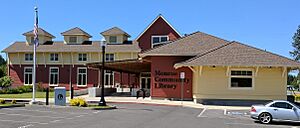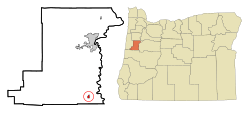Monroe, Oregon facts for kids
Quick facts for kids
Monroe, Oregon
|
|
|---|---|
|
City
|
|

Monroe community library
|
|

Location in Oregon
|
|
| Country | United States |
| State | Oregon |
| County | Benton |
| Incorporated | 1914 |
| Area | |
| • Total | 0.52 sq mi (1.33 km2) |
| • Land | 0.52 sq mi (1.33 km2) |
| • Water | 0.00 sq mi (0.00 km2) |
| Elevation | 292 ft (89 m) |
| Population
(2020)
|
|
| • Total | 647 |
| • Estimate
(2023)
|
763 |
| • Density | 1,256.31/sq mi (485.38/km2) |
| Time zone | UTC-8 (Pacific) |
| • Summer (DST) | UTC-7 (Pacific) |
| ZIP code |
97456
|
| Area code(s) | 541 |
| FIPS code | 41-49600 |
| GNIS feature ID | 2411135 |
Monroe is a city in Benton County, Oregon, United States. The population was 763 as of the 2023 census population estimates. It is part of the Corvallis, Oregon Metropolitan Statistical Area. Monroe is located midway between Eugene and Corvallis along Highway 99W.
Geography
According to the United States Census Bureau, the city has a total area of 0.51 square miles (1.32 km2), all of it land.
History
The city was formed around a small sawmill established by Joseph White in 1852. By 1853, there was a small settlement known as White's Mill. Around the same time, Roland Hinton formed the town of Starr Point north of White's Mill. In 1857, Starr Point combined with White's Mill to form the town of Monroe. The city quickly became a center for paddle boat traffic.
It was one of the largest cities in the state for many years. Monroe High School was built in the 1920s. Since the construction of the Interstate 5 highway in the 1960s, the city has turned into a rural farming community. It is the site of the historic Hull-Oakes Lumber Mill, the only steam-powered sawmill operating in the U.S.
Demographics
| Historical population | |||
|---|---|---|---|
| Census | Pop. | %± | |
| 1880 | 135 | — | |
| 1920 | 191 | — | |
| 1930 | 227 | 18.8% | |
| 1940 | 311 | 37.0% | |
| 1950 | 362 | 16.4% | |
| 1960 | 374 | 3.3% | |
| 1970 | 443 | 18.4% | |
| 1980 | 412 | −7.0% | |
| 1990 | 448 | 8.7% | |
| 2000 | 607 | 35.5% | |
| 2010 | 617 | 1.6% | |
| 2020 | 647 | 4.9% | |
| U.S. Decennial Census | |||
2010 census
At the 2010 census, there were 617 people, 251 households and 165 families residing in the city. The population density was 1,209.8 people per square mile (467.1 people/km2). There were 277 housing units at an average density of 543.1 units per square mile (209.7 units/km2). The racial make-up of the city was 89.0% White, 0.2% African American, 1.3% Native American, 0.2% Asian, 6.6% from other races, and 2.8% from two or more races. Hispanic or Latino people of any race were 16.2% of the population.
There were 251 households, of which 26.7% had children under the age of 18 living with them, 46.6% were married couples living together, 12.0% had a female householder with no husband present, 7.2% had a male householder with no wife present and 34.3% were non-families. 25.1% of all households were made up of individuals, and 8% had someone living alone who was 65 years of age or older. The average household size was 2.46 and the average family size was 2.92.
The median age was 42.7 years. 21.6% of residents were under the age of 18, 7.7% were between the ages of 18 and 24, 23.7% were from 25 to 44, 33.7% were from 45 to 64 and 13.1% were 65 years of age or older. The sex makeup of the city was 50.2% male and 49.8% female.
Notable people
- Willis C. Hawley, a member of the United States House of Representatives from 1909 to 1933
- Dave Wolverton, writer and novelist
See also
 In Spanish: Monroe (Oregón) para niños
In Spanish: Monroe (Oregón) para niños

